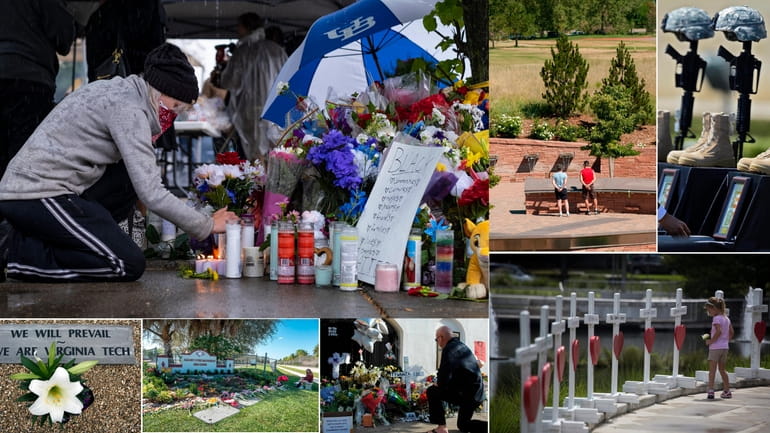Red flags behind mass killings

Memorials to mass shootings, clockwise, from top, Buffalo, N.Y.; Columbine High School in Littleton, Colo; Fort Hood, Texas; Orlando, Fla.; Charleston, S.C.; Parkland, Fla.; and Virginia Tech in Blacksburg, Va. Credit: Craig Ruttle (Buffalo); Ryan Dearth (Columbine); EPA / Larry W. Smith (Fort Hood); EPA / John Taggart (Orlando); John Roca (Charleston); EPA-EFE/ Shutterstock/ Cristobal Herrera-Ulashkevich (Parkland); and AP / Steve Helber (Virginia Tech)
As the shooting deaths of 10 Black people in a Buffalo supermarket blasted into the public consciousness last weekend, a familiar question was raised. Were there warning signs?
There were, as is common. They went unheeded, as is common.
The alleged shooter in the Buffalo killings, Payton S. Gendron, 18, was asked about his plans for after graduation by a teacher last year.
“I want to murder and commit suicide,” Gendron replied.
He was referred to a hospital for a mental health evaluation and counseling, but released after 36 hours. In his lengthy online statement he said he lied to the counselors during the exam. A red flag order to remove guns from his possession, legal in New York and 18 other states, was never sought. Follow-up that could have unearthed his violent, racist and antisemitic online posts and mindset never occurred.
Sound familiar?
Before 19-year-old Nikolas Cruz murdered 17 people at a Parkland, Florida, high school in 2018, he was expelled from there. An email sent to staff said he’d threatened students. The Florida Department of Children and Families investigated, and numerous incidents and online postings showed he was fantasizing about violence. Then he legally bought numerous weapons. It’s Cruz’s story that led to the passage of red flag laws in Florida and elsewhere.
Dylann Roof, who killed nine Black people in a Charleston church in 2015, had pending charges against him that should have made it impossible to legally buy the gun he used. He also openly embodied a violent racism, in person and online.
In Orlando in 2016, in Aurora in 2012, at Fort Hood in 2009, at Virginia Tech in 2007 and all the way back to Columbine High School in Colorado in 1999, the signs of impending carnage were present — as was the possibility of heading off those killings.
According to a study by the advocacy group Everytown For Gun Safety, 56% of those who committed mass murders from 2009 through 2020 exhibited dangerous warning signs. One-third were already prohibited from possessing firearms.
PLENTY CAN BE DONE
So it’s not that nothing can be done to prevent the next incident. Plenty can be done, but too often isn’t.
Experts agree on the signs: violent social media posts, texts in which violence is mentioned, online searches for guns and weapons and mass murderers, and family trouble and isolation are common ones.
They also agree on the best way to assure problems are flagged, and addressed: Detection demands community reporting that is confidential and effective, trained professionals following up, and connections between schools and other sectors.
And making sure a warning ignored doesn’t turn into a bloodbath demands mental health and law-enforcement professionals develop personalized connections to the highest-risk subjects, then track and follow up with them.
Why doesn’t that happen more, and what’s being done right where it does?
In 31 states there are no red flag laws, a sign of blind, dangerous and exaggerated fealty to the 2nd Amendment. This goes along with the illogic of gun-rights politicians who claim the issue is mental illness, not guns, but won’t support red flag laws to temporarily disarm those suffering from such conditions.
INTERVENTIONS RARE
And in most places that allow authorities, and in some cases family members and or co-workers, to ask judges to temporarily seize guns or bar people suspected of being a danger to themselves and others from buying them, it rarely happens.
In New York City, for instance, the law has been used to confiscate guns just five times since 2019. In Hawaii it has only been used once.
But in Florida, where the Parkland killings led to the national movement to pass red flag laws, the state took guns 2,355 times last year.
In New York State, Suffolk County is a leader in acting on red -flag warnings, with 163 seizures since 2019. County officials say extensive training in the police and sheriff’s departments are a big reason why. The numbers also show that judges and mental health professionals are taking such threats seriously.
After the Buffalo killings, Gov. Kathy Hochul ordered State Police to seek emergency orders to seize weapons from people posing a threat. State Police will also oversee a new unit to track extremism online. That, and an improvement passed last year that requires mental health facilities to gather and provide information on how to seek protection orders for discharged patients, are smart steps if followed.
In many states where the laws exist, they are poorly publicized and understood. And parents and educators and mental health professionals who do seek such interventions can be stymied.
But many states don’t have these laws. They need them.
This country has about 400 million guns according to the nonpartisan Small Arms Survey, which monitors gun ownership. Most are owned by law-abiding owners, and will never be used in a crime.
But the right of gun ownership must be balanced with people’s safety and with the well-being of a disturbed person. An intervention does as much to prevent the destruction of a that person’s life as it does to save potential victims, and potential killers who tip their hands often do so hoping to be stopped.
MEMBERS OF THE EDITORIAL BOARD are experienced journalists who offer reasoned opinions, based on facts, to encourage informed debate about the issues facing our community.
